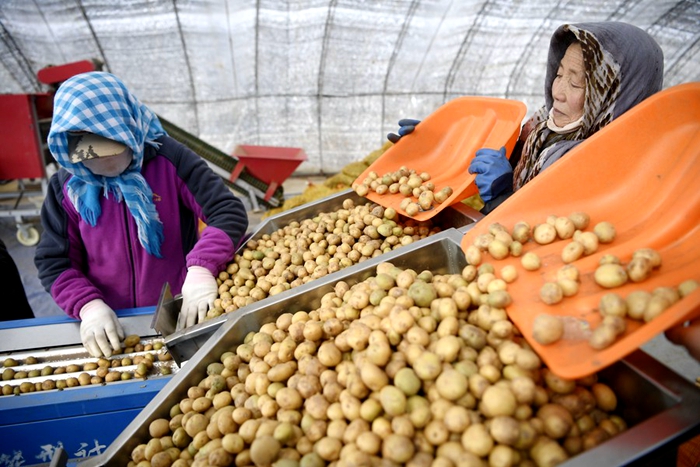[Xinhua] Chinese scientists achieve new breakthrough in hybrid potato breeding

Staff members sort out potatoes at a potato cultivation center in Xiji County, northwest China's Ningxia Hui Autonomous Region, March 2, 2023. (Xinhua/Wang Peng)
BEIJING, May 5 (Xinhua) -- Chinese scientists have made a new breakthrough in hybrid potato breeding by using evolutionary genomics to identify deleterious mutations, which may help shorten the breeding process and generate more and better potato varieties.
The breakthrough, made by a research team from the Agricultural Genomics Institute at Shenzhen under the Chinese Academy of Agricultural Sciences, was published online in the latest issue of the scientific journal Cell.
Potato is the most important tuber food crop and one of the staple crops in most countries around the world, including China. Compared with other staple crops, potato needs less water and can be planted in a wide range of areas, said Wu Yaoyao, a key member of the research team.
"But breeding a new potato variety takes too long. The potato variety used for McDonald's fries was bred over 120 years ago," Wu said.
The main reason is that potato is tetraploid, which means it has four sets of genomes, and depends on asexual propagation through tubers, which has a long breeding cycle and low reproduction efficiency, while the tubers are also easily infected with diseases and prone to pests, Wu said.
The research team launched a "Ubiquitous Potato Project," aiming to transform potato reproduction from asexual to sexual, and from reliance on tubers to reliance on seeds, and guide potato breeding by using genomics and synthetic biology.
In order to breed consistent high-quality potato varieties, scientists need to obtain high homozygous inbred lines by continuous self-fertilization, so that hybrid commercial lines can be produced with consistent properties, Wu explained.
However, during the long-term asexual reproduction history of the potato, a large number of hidden deleterious mutations accumulated. Once self-fertilized, these previously "invisible" mutations will unveil their adverse impact on the plants such as reduced viability, sterility, lowered disease resistance and yield. This phenomenon, known as inbreeding depression, represents a major hurdle in hybrid potato breeding.
"Overcoming the deleterious mutations is the most difficult task in this research," said Huang Sanwen, leader of the research team.
The researchers collected and compared genomic information from 100 Solanaceae and Convolvulaceae materials with an accumulated evolution history of 1.2 billion years. Potato belongs to the Solanaceae family, while sweet potato belongs to the Convolvulaceae family.
"We observed that after 1.2 billion years of evolution, if a gene or a piece of DNA of plants remains unchanged, it indicates that it is particularly important. We have identified the most conserved and unchanging sites in the genome," Huang said.
"If these gene sites mutate, it is more likely to have adverse effects on potatoes, that is, deleterious mutations. We have explored the whole picture of deleterious mutations at the genome-wide level, and created the first two-dimensional map of potato deleterious mutations. Therefore, we could search for and eliminate deleterious mutations more comprehensively and efficiently," Huang said.
The research team also developed a new whole-genome prediction model incorporating deleterious mutation information into it, which could significantly improve the prediction accuracy of traits such as yield, plant height and tuber shape by 25 to 45 percent. The model could assist breeders in making early breeding decisions, thereby reducing breeding costs and shortening the breeding process of potatoes.
The research could increase the efficiency of potato breeding by about 50 percent, providing a basis for variety improvement. The technology could also be applied in improving other crops, such as sweet potatoes, fruits, sugarcane, as well as many tropical crops, Huang added.
-
 Apr 18, 2024Opening Ceremony of the Training Workshop on Wheat Head Scab Resistance Breeding and Pest Control in Africa Held in CAAS
Apr 18, 2024Opening Ceremony of the Training Workshop on Wheat Head Scab Resistance Breeding and Pest Control in Africa Held in CAAS -
 Apr 03, 2024IPPCAAS Co-organized the Training Workshop on Management and Application of Biopesticides in Nepal
Apr 03, 2024IPPCAAS Co-organized the Training Workshop on Management and Application of Biopesticides in Nepal -
 Mar 28, 2024Delegation from the School of Agriculture and Food Science of University College Dublin, Ireland Visit to IAS, CAAS
Mar 28, 2024Delegation from the School of Agriculture and Food Science of University College Dublin, Ireland Visit to IAS, CAAS -
 Mar 25, 2024Director of World Food Prize Foundation visited GSCAAS
Mar 25, 2024Director of World Food Prize Foundation visited GSCAAS -
 Mar 20, 2024Institute of Crop Sciences (ICS) and Syngenta Group Global Seeds Advance Collaborative Research in the Seed Industry
Mar 20, 2024Institute of Crop Sciences (ICS) and Syngenta Group Global Seeds Advance Collaborative Research in the Seed Industry
